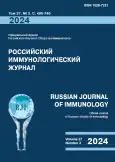Клинические и эпидемиологические аспекты первичных иммунодефицитов в Республике Каракалпакстан
- Авторы: Каландарова А.Н.1, Жиемуратова Г.К.1, Исмаилова А.А.2, Маткаримова А.А.3
-
Учреждения:
- Нукусский филиал института иммунологии и геномики человека Академии наук Республики Узбекистан
- Институт иммунологии и геномики человека Академии наук Республики Узбекистан
- Многопрофильный детский центр Республики Каракалпакстан
- Выпуск: Том 27, № 3 (2024)
- Страницы: 567-572
- Раздел: КРАТКИЕ СООБЩЕНИЯ
- URL: https://journal-vniispk.ru/1028-7221/article/view/267525
- DOI: https://doi.org/10.46235/1028-7221-16883-CAE
- ID: 267525
Цитировать
Полный текст
Аннотация
Изучение распространенности ПИД является важным аспектом эпидемиологических исследований, поскольку оно позволяет оценить частоту возникновения этих заболеваний на различных территориях. Распределение ПИД может различаться в зависимости от этнической принадлежности и географического положения. Информация о распространенности ПИД на региональном, национальном и международном уровнях позволяет более точно определить масштаб проблемы и разработать эффективные стратегии профилактики и лечения.
Изучение эпидемиологической и клинической картины врожденных иммунных нарушений (ПИД) в Республике Каракалпакстан имеет большое значение для понимания распространенности, возрастной и гендерной структуры, а также спектра нозологических форм этих редких заболеваний.
Целью настоящего исследования явилось изучение эпидемиологических и клинических особенностей врожденных иммунных нарушений первичных иммунодефицитов в Республике Каракалпакстан. Материалом исследования служили данные о больных, находящихся на стационарном лечении в многопрофильной детской больнице РК, и состоящие на диспансерном учете у аллерголога-иммунолога в консультативной поликлинике при районных медицинских центрах РК.
Задержка постановки диагноза с момента клинической манифестации ПИД составила в регионе в среднем 2,7 лет. Было установлено, что количество случаев летального исхода составило 2,8%. Скрининговые тесты верификации ПИД на этапе диагностического поиска включали клинический и биохимический анализы крови, определение сывороточных иммуноглобулинов. На момент выставления диагноза у больных обнаруживалось выраженное снижение уровней иммуноглобулинов IgG и IgА. Помимо нарушения в гуморальном звене адаптивного иммунитета у детей с данным заболеванием выявлялось уменьшение абсолютного числа Т-лимфоцитов.
Полученные данные из исследования указывают на недостаточную диагностику первичных иммунодефицитов в РК, что может послужить основой для разработки образовательных программ, способствующих повышению осведомленности о первичных иммунодефицитах. Дальнейшие исследования и систематизация информации о пациентах с первичными иммунодефицитами необходимы для разработки региональных программ по внедрению скрининговой диагностики.
Полный текст
Открыть статью на сайте журналаОб авторах
А. Н. Каландарова
Нукусский филиал института иммунологии и геномики человека Академии наук Республики Узбекистан
Email: gulparshin_76@mail.ru
д.м.н., заведующая лабораторией
Узбекистан, НукусГ. К. Жиемуратова
Нукусский филиал института иммунологии и геномики человека Академии наук Республики Узбекистан
Автор, ответственный за переписку.
Email: gulparshin_76@mail.ru
к.м.н., старший научный сотрудник
Узбекистан, НукусА. А. Исмаилова
Институт иммунологии и геномики человека Академии наук Республики Узбекистан
Email: gulparshin_76@mail.ru
д.м.н., профессор заведующая лабораторией фундаментальной иммунологии
Узбекистан, ТашкентА. А. Маткаримова
Многопрофильный детский центр Республики Каракалпакстан
Email: gulparshin_76@mail.ru
к.м.н., доцент, главный врач
Узбекистан, НукусСписок литературы
- Атаханова Д.О., Мадреймов А.М. Модель санитарно-эпидемиологического и экологического мониторинга в Республике Каракалпакстан. Методические рекомендации. Нукус, 2017. 10 с. [Atakhanova D.O., Madreymov A.M. Model of sanitary-epidemiological and environmental monitoring in the Republic of Karakalpakstan. Methodical Recommendations]. Nukus, 2017. 10 p
- Газалиева М.А., Ахметова Н.Ш., Жумабекова Б.К., Казимирова О.В., Абдикаликова Д.Р., Абдил А., Ташенов М. Состояние иммунологического здоровья населения экологически неблагополучных регионов Казахстана // Научное обозрение, медицинские науки, 2016. № 5. С. 32-39. [Gаzaliyeva М.А., Аkhmetova N.Sh., Zhumabekova B.K., Kazimirova O.V., Abdikalikova D.R., Abdil A., Tashenov M. Status of population health ecologically disadvantaged regions of Kazakhstan. Nauchnoe obozrenie, meditsinskie nauki = Journal of Medical Sciences, 2016, no. 5, pp. 32-39. (In Russ.)]
- Кондратенко И.В., Болгов А.А. Первичные иммунодефициты. М.: МЕДПРАКТИКА-М, 2005. 232 с. [Kondratenko, I.V., Bolgov, A.A. Primary Immunodeficiencies]. Moscow: MEDPRAKTIKA-M, 2005. 232 p.
- Мухина А.А., Кузьменко Н.Б., Родина Ю.А., Кондратенко И.В., Бологов А.А. Характеристика пациентов с первичными иммунодефицитными состояниями в Российской Федерации: от рождения до старости. // Педиатрия им. Г.Н. Сперанского, 2019. Т. 98, № 3. С. 24-31. [Mukhina А.А., Kuzmenko N.B., Rodina Yu.A., Kondratenko I.V., Bologov A.A. Characteristics of patients with primary immunodeficiency states in the Russian Federation: from birth to old age. Pediatriya im. G.N. Speranskogo = Pediatrics n. a. G.N. Speransky, 2019, Vol. 98, no. 3, pp. 24-31. (In Russ.)]
- Сизякина Л.П., Андреева И.И. Создание регистра пациентов как эффективный инструмент диагностики первичных иммунодефицитов // Педиатрическая фармакология, 2013. Т. 10, № 5. С. 94- 96. [Sizyakina, L.P., Andreeva, I.I. Creation of Patient Registry as an Effective Tool for Diagnosing Primary Immunodeficiencies. Pediatricheskaya farmakologiya = Pediatric Pharmacology, 2013, Vol. 10, no. 5, pp. 94-96. (In Russ.)]
- Тузанкина И.А., Каракина М.Л., Власова Е.В. Анализ клинических проявлений дебюта первичных иммунодефицитов у взрослых // Медицинская иммунология, 2014. Т. 16, № 4. С. 367-374. [Tuzankina I.A., Karakina M.L., Vlasova E.V. Analysis of clinical manifestations of debut of primary immunodeficiencies in adults. Meditsinskaya immunologiya = Medical Immunology (Russia), 2014, Vol. 16, no. 4, pp. 367-374. (In Russ.)] doi: 10.15789/1563-0625-2014-4-367-374.
- Хаитов P.M., Пинегин Б.В., Ярилин А.А. Руководство по клинической иммунологии. М.: ГЭОТАР-Медиа. 2009. 350 с. [Khaitov R.M., Pinegin B.V., Yarilin A.A. Handbook of Clinical Immunology. Moscow: GEOTAR-Media, 2009. 350 p.
- Conley M.E., Notarangelo L.D., Etzioni A. Diagnostic criteria for primary immunodeficiencies. Representing PAGID (Pan-American Group for Immunodeficiency) and ESID (European Society for Immunodeficiencies). Clin. Immunol., 1999, Vol. 93, no. 3, pp. 190-197.
- Kindle G., Gathmann B., Grimbacher B. The use of databases in primary immunodeficiencies. Curr. Opin. Allergy Clin. Immunol., 2014, Vol. 14, pp. 501-508.
- Seidel M.G., Kindle G., Gathmann B., Quinti I., Buckland M., van Montfrans J., Scheible R., Rusch S., Gasteiger L.M., Grimbacher B., Mahlaoui N., Ehl S.; ESID Registry Working Party and collaborators. The European Society for Immunodeficiencies (ESID) registry working definitions for the clinical diagnosis of inborn errors of immunity. J. Allergy Clin. Immunol. Pract., 2019, Vol. 7, no. 6, pp. 1763-1770.
Дополнительные файлы







